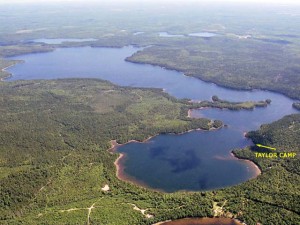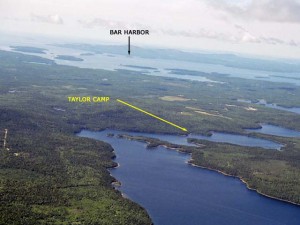Tunk Lake is very warm, clean, and is one of the deepest in Maine. It is great for swimming, hiking, fishing, boating… or just relaxing.
Currently the land (including 25 miles of shoreline) surrounding Tunk Lake is protected by a small handful of owners including the State of Maine. It remains practically unchanged over the past 100 years. Purchasing property at any price is virtually impossible.

The following is an article from the Winter 1994 in Maine Heritage, the Newsletter of Maine Coast Heritage Trust.
Tunk Region
Wild, Beautiful & Protected
For many years, 2 families, Main Coast Heritage Trust, and state conservation officials held similar visions to protect a magnificent area in eastern Hancock County surrounding Tunk Lake. In August 1994 when the Land for Maine’s Future Board (LMFB) purchased approximately 7,200 acres of area from the Pierce family, the transaction became the crowning achievement in a conservation story of remarkable dimensions.
Approximately fifteen miles east of Ellsworth, more than 16,000 acres of mountains, summits, crystal clear lakes, and rich forests have been protected. After the August purchase, the state owns approximately 14,000 acres, managed by the Bureau of Public lands as a reserve. The region’s long traditions of canoeing, hiking, hunting, fishing, and swimming will continue and over time, will become available. With MCHT’s assistance, private owners have placed conservation easements on the remaining land to limit future development, and protect scenic shorelines.
The enormous protected area embraces a diverse mosaic of natural communities, including wetlands, bogs, rare pine-health woodlands, and impressive stands of old-growth red spruce. In the heart of the region, surrounded by mountains and ringed by ponds, lies Tunk Lake – with sand beaches, coves, and forested shores. Tunk is reported to be the clearest lake in Maine, the second deepest, and an important cold-water fishery.
Close to a region that has experienced tremendous pressure for 2nd home development, Tunk is a lake so wild, so beautiful, that like a magnet, it has drawn people to protect it. The believe that Tunk could be protected galvanized land owners, state officials, am MCHT staff and Board to work collaboratively and persistently over the past eighteen years. They used an arsenal of land conservation techniques: bargain sales, trades, conservation easements, and conservation buyers. MCHT facilitated ten of these transactions. “Tunk is one of the most complex and creative projects we’ve ever undertaken”, according to Trust President Jay Espy.
Two Essential Families
Throughout the years, two families – The Bryans and the Pierces – were crucial, motivating forces. The legacy of Bryan family protection efforts began in 1976 when Hazel Bryan Tracy worked with MCHT to grant a conservation easement on her shorefront property at Tunk Lake.
For many years following, staff worked with brothers James T Bryan and Robert A Bryan, and other family members to help them protect their land. To date, the Bryans have protected approximately nine properties, including Wickyup, the former summer compound of polar explorer Richard E Byrd, with five miles of shoreline on Tunk Lake and Little Tunk Pond.
Pierce Families Critical Parcel
To the North and east, in Township 10, was another family with long-term ties to the region. John M Pierce first spoke with the state twenty years ago about preserving the property that he owned with his sister, Mary P Ridlon, at Spring River and Tunk Lakes. “We wanted it to stay the way it was, not knowing what the future would be”, says Pierce. Bisected by State Route 182, the extraordinary tract includes more than 16 miles of lake frontage, several entire ponds, outstanding wetlands and wildlife habitat, and the south side of Tunk Mountain. Pierce and Ridlon inherited the land from their father along with his deep commitment to serving as its guardian and steward.
In 1984 they sought advice from MCHT about conservation options for their 7,200 acres. Over the next ten years, MCHT helped the Pierce family and the State of Maine explore many different options for protecting this spectacular land.
In March 1994, after years of negotiations – with MCHT serving as a neutral third party – the LMFB announced its plans to purchase the Pierce/Ridlon land. This was the crowning achievement to the long Tunk story, and the second largest deal for the LMFB. “I don’t have a crystal ball, but I believe that Tunk Lake will stand out as a singular great accomplishment of the Land for Maine’s Future program,” said Caroline Pryor, MCHT vice-president and lead staff person for the project. “It means so much to so many”.
Today Tunk Lake is surrounded by protective forces. John Pierce retains land and a camp on Spring River Lake. The Bryans continue to own land on Tunk. The Bureau of Public lands will protect and maintain their Tunk Lake property in conjunction with adjacent holdings at Donnell Pond, balancing the protection of natural resources with public recreation and commercial forestry. Other land owners continue to join in the protection effort and are working with MCHT, the state, and local Frenchman Bay Conservancy on conservation easements. And very importantly, the people who hike, hunt, and boat in the area will lay a central role in the stewardship of this land through their use.
The experience in the Tunk Lake region illustrates the value of collaborative conservation efforts, especially when protecting land on such a large scale. This is the story of families whose vision to protect the character of an entire region – a landscape – was encouraged and assisted by MCHT and made concrete by the state of Maine. It’s about “names, history, and feelings” says Edwin C Meadows, conservation commissioner and former chairman of the Land for Maine’s Future Board. “The government can do a lot, but it can’t do a lot by itself. The best things happen when we work with the private and non-profit sectors.

